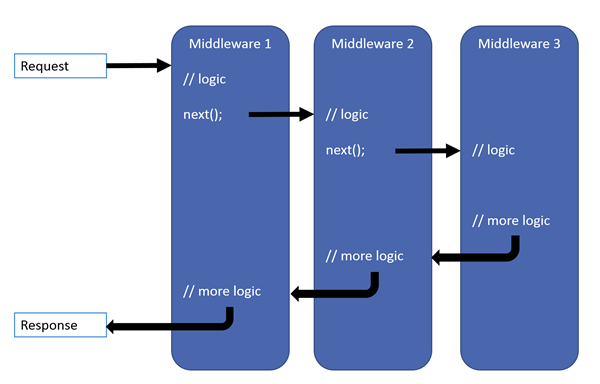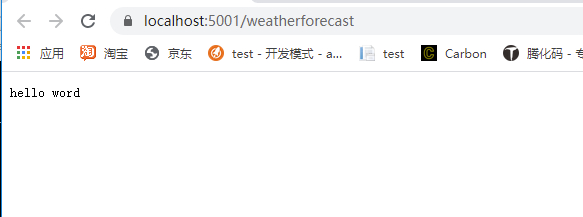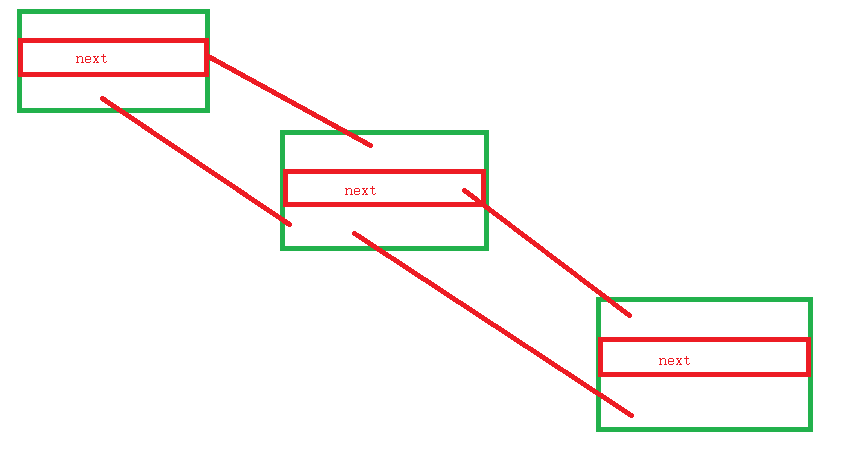重新整理 .net core 实践篇—————中间件[十九]
前言
简单介绍一下.net core的中间件。
正文
官方文档已经给出了中间件的概念图:

和其密切相关的是下面这两个东西:
IApplicationBuilder 和 RequestDelegate(HttpContext context)
IApplicationBuilder :
public interface IApplicationBuilder
{
IServiceProvider ApplicationServices { get; set; }
IFeatureCollection ServerFeatures { get; }
IDictionary<string, object> Properties { get; }
IApplicationBuilder Use(Func<RequestDelegate, RequestDelegate> middleware);
IApplicationBuilder New();
RequestDelegate Build();
}
RequestDelegate:
namespace Microsoft.AspNetCore.Http
{
public delegate Task RequestDelegate(HttpContext context);
}
举一个 中间件的例子:
app.Use(async (context, next) => {
await context.Response.WriteAsync("hello word");
});
效果:

这里我没有执行next,故而在这里就终止了。
来看下这个Use,干了什么:
public static class UseExtensions
{
public static IApplicationBuilder Use(
this IApplicationBuilder app,
Func<HttpContext, Func<Task>, Task> middleware)
{
return app.Use((Func<RequestDelegate, RequestDelegate>) (next => (RequestDelegate) (context =>
{
Func<Task> func = (Func<Task>) (() => next(context));
return middleware(context, func);
})));
}
}
是的,他是对IApplicationBuilder 的一个扩展。
如果不想使用这个扩展方法,那么你要这么写:
app.Use((Func<RequestDelegate, RequestDelegate>) (next=> (RequestDelegate)((context)=>
{
Func<Task> func = (Func<Task>)(() => next(context));
Func<HttpContext, Func<Task>, Task> middleware = async (context1, next2) =>
{
await context1.Response.WriteAsync("hello word");
};
return middleware(context, func);
})));
有些人可能看不惯这样写哈,换一种写法:
app.Use((Func<RequestDelegate, RequestDelegate>) (next =>
{
return (RequestDelegate)((context) =>
{
Func<Task> func = (Func<Task>)(() => next(context));
Func<HttpContext, Func<Task>, Task> middleware = async (context1, next2) =>
{
await context1.Response.WriteAsync("hello word");
};
return middleware(context, func);
});
}));
又或者,这样写:
app.Use((Func<RequestDelegate, RequestDelegate>) (next =>
{
return (RequestDelegate)((context) =>
{
Func<HttpContext, RequestDelegate, Task> middleware = async (context1, next2) =>
{
await context1.Response.WriteAsync("hello word");
};
return middleware(context, next);
});
}));
还可以这样写:
public async Task WriteAsync(HttpContext context, RequestDelegate requestDelegate)
{
await context.Response.WriteAsync("hello word");
}
app.Use((Func<RequestDelegate, RequestDelegate>) (next =>
{
return (RequestDelegate)((context) => WriteAsync(context, next));
}));
上面没有用到这个next,那么这个next是干什么的呢?从上面的传参推断出,就是我们的下一步。
如果没有执行下一步,那么下一步是不会执行的。
来看一下IApplicationBuilder的实现类ApplicationBuilder的use方法:
private readonly IList<Func<RequestDelegate, RequestDelegate>> _components = (IList<Func<RequestDelegate, RequestDelegate>>) new List<Func<RequestDelegate, RequestDelegate>>();
public IApplicationBuilder Use(
Func<RequestDelegate, RequestDelegate> middleware)
{
this._components.Add(middleware);
return (IApplicationBuilder) this;
}
会将我们传入的middleware,加入到_components 中。
ApplicationBuilder看下build 方法:
public RequestDelegate Build()
{
RequestDelegate requestDelegate = (RequestDelegate) (context =>
{
Endpoint endpoint = context.GetEndpoint();
if (endpoint?.RequestDelegate != null)
throw new InvalidOperationException("The request reached the end of the pipeline without executing the endpoint: '" + endpoint.DisplayName + "'. Please register the EndpointMiddleware using 'IApplicationBuilder.UseEndpoints(...)' if using routing.");
context.Response.StatusCode = 404;
return Task.CompletedTask;
});
foreach (Func<RequestDelegate, RequestDelegate> func in this._components.Reverse<Func<RequestDelegate, RequestDelegate>>())
requestDelegate = func(requestDelegate);
return requestDelegate;
}
这个就是套娃工程,把后面一个的requestDelegate,作为前面一个requestDelegate的参数。最后返回第一个requestDelegate。
断点验证,我打了两个断点,下面是断点的顺序。
第一个断点停留的位置:

第二个断点停留的位置:

第二个断点里面的next就是第一个断点返回的结果。
因为返回的是第一个中间件的返回的RequestDelegate,那么运行。
那么运行顺序就是第一个返回的RequestDelegate开始运行,且参数是第二个中间件返回的RequestDelegate。
返回的RequestDelegate运行顺序如下:

这大概就是中间件的原理了。
下面看一下动态中间件:
app.Map("/abc", builder =>
{
app.Use((Func<RequestDelegate, RequestDelegate>)(next =>
{
return (RequestDelegate)((context) => WriteAsync(context, next));
}));
});
如上面这样,如果匹配到了/abc,那么就走里面的中间件。
看下源码吧,Map的。
public static class MapExtensions
{
public static IApplicationBuilder Map(
this IApplicationBuilder app,
PathString pathMatch,
Action<IApplicationBuilder> configuration)
{
if (app == null)
throw new ArgumentNullException(nameof (app));
if (configuration == null)
throw new ArgumentNullException(nameof (configuration));
if (pathMatch.HasValue && pathMatch.Value.EndsWith("/", StringComparison.Ordinal))
throw new ArgumentException("The path must not end with a '/'", nameof (pathMatch));
IApplicationBuilder applicationBuilder = app.New();
configuration(applicationBuilder);
RequestDelegate requestDelegate = applicationBuilder.Build();
MapOptions options = new MapOptions()
{
Branch = requestDelegate,
PathMatch = pathMatch
};
return app.Use((Func<RequestDelegate, RequestDelegate>) (next => new RequestDelegate(new MapMiddleware(next, options).Invoke)));
}
}
里面做的主要是两件事,一件事是另外 app.New();弄出一条分支出来。然后调用Build()独立走出一条新的中间件链。
New方法如下:
public IApplicationBuilder New()
{
return (IApplicationBuilder) new ApplicationBuilder(this);
}
第二件事就是返回了一个新的中间件RequestDelegate,传入了两个参数一个是next,这个是用来走老的分支,估摸着不匹配的时候走旧的分支。
还有一个参数是options,这个参数有两个属性,一个是Branch 就是新的分支。一个是PathMatch 是匹配字符,那么就是如果是匹配的话,就走新的分支。
事实证明果然如此:
public class MapMiddleware
{
private readonly RequestDelegate _next;
private readonly MapOptions _options;
public MapMiddleware(RequestDelegate next, MapOptions options)
{
if (next == null)
throw new ArgumentNullException(nameof (next));
if (options == null)
throw new ArgumentNullException(nameof (options));
this._next = next;
this._options = options;
}
public async Task Invoke(HttpContext context)
{
if (context == null)
throw new ArgumentNullException(nameof (context));
PathString matched;
PathString remaining;
if (context.Request.Path.StartsWithSegments(this._options.PathMatch, out matched, out remaining))
{
PathString path = context.Request.Path;
PathString pathBase = context.Request.PathBase;
context.Request.PathBase = pathBase.Add(matched);
context.Request.Path = remaining;
try
{
await this._options.Branch(context);
}
finally
{
context.Request.PathBase = pathBase;
context.Request.Path = path;
}
path = new PathString();
pathBase = new PathString();
}
else
await this._next(context);
}
}
还可以这样自定义:
app.MapWhen(context =>
{
return context.Request.Query.Keys.Contains("abc");
}, builder =>
{
app.Use((Func<RequestDelegate, RequestDelegate>)(next =>
{
return (RequestDelegate)((context) => WriteAsync(context, next));
}));
});
有了上面的简单分析,应该不难理解哈。
我这里直接贴了:
MapWhen:
public static class MapWhenExtensions
{
public static IApplicationBuilder MapWhen(
this IApplicationBuilder app,
Func<HttpContext, bool> predicate,
Action<IApplicationBuilder> configuration)
{
if (app == null)
throw new ArgumentNullException(nameof (app));
if (predicate == null)
throw new ArgumentNullException(nameof (predicate));
if (configuration == null)
throw new ArgumentNullException(nameof (configuration));
IApplicationBuilder applicationBuilder = app.New();
configuration(applicationBuilder);
RequestDelegate requestDelegate = applicationBuilder.Build();
MapWhenOptions options = new MapWhenOptions()
{
Predicate = predicate,
Branch = requestDelegate
};
return app.Use((Func<RequestDelegate, RequestDelegate>) (next => new RequestDelegate(new MapWhenMiddleware(next, options).Invoke)));
}
}
MapWhenMiddleware:
public class MapWhenMiddleware
{
private readonly RequestDelegate _next;
private readonly MapWhenOptions _options;
public MapWhenMiddleware(RequestDelegate next, MapWhenOptions options)
{
if (next == null)
throw new ArgumentNullException(nameof (next));
if (options == null)
throw new ArgumentNullException(nameof (options));
this._next = next;
this._options = options;
}
public async Task Invoke(HttpContext context)
{
if (context == null)
throw new ArgumentNullException(nameof (context));
if (this._options.Predicate(context))
await this._options.Branch(context);
else
await this._next(context);
}
}
上面都是异曲同工,就不做解释了。
这里再介绍一个方法,run:
app.Run(async context =>
{
await context.Response.WriteAsync("hello word");
});
这个这个Run方法,没有传入next。
如下:
public static void Run(this IApplicationBuilder app, RequestDelegate handler)
{
if (app == null)
throw new ArgumentNullException(nameof (app));
if (handler == null)
throw new ArgumentNullException(nameof (handler));
app.Use((Func<RequestDelegate, RequestDelegate>) (_ => handler));
}
表示这是末端。
那么下面介绍一下,将我们的中间件写入到一个独立的类里面去。
定义一个扩展类:
public static class SelfBuilderExtensions
{
public static IApplicationBuilder UseSelfSelfMiddleware(this IApplicationBuilder app)
{
return app.UseMiddleware<SelfMiddleware>();
}
}
具体的实现:
public class SelfMiddleware
{
private readonly RequestDelegate _next;
public SelfMiddleware(RequestDelegate next)
{
this._next = next;
}
public async Task InvokeAsync(HttpContext context)
{
Console.WriteLine("request handle");
await this._next(context);
Console.WriteLine("response handle");
}
}
使用:
app.UseSelfSelfMiddleware();
简单看一下UseMiddleware这个方法:
public static IApplicationBuilder UseMiddleware<TMiddleware>(
this IApplicationBuilder app,
params object[] args)
{
return app.UseMiddleware(typeof (TMiddleware), args);
}
继续看app.UseMiddleware:
public static IApplicationBuilder UseMiddleware(
this IApplicationBuilder app,
Type middleware,
params object[] args)
{
if (typeof (IMiddleware).GetTypeInfo().IsAssignableFrom(middleware.GetTypeInfo()))
{
if (args.Length != 0)
throw new NotSupportedException(Resources.FormatException_UseMiddlewareExplicitArgumentsNotSupported((object) typeof (IMiddleware)));
return UseMiddlewareExtensions.UseMiddlewareInterface(app, middleware);
}
IServiceProvider applicationServices = app.ApplicationServices;
return app.Use((Func<RequestDelegate, RequestDelegate>) (next =>
{
MethodInfo[] array = ((IEnumerable<MethodInfo>) middleware.GetMethods(BindingFlags.Instance | BindingFlags.Public)).Where<MethodInfo>((Func<MethodInfo, bool>) (m => string.Equals(m.Name, "Invoke", StringComparison.Ordinal) || string.Equals(m.Name, "InvokeAsync", StringComparison.Ordinal))).ToArray<MethodInfo>();
if (array.Length > 1)
throw new InvalidOperationException(Resources.FormatException_UseMiddleMutlipleInvokes((object) "Invoke", (object) "InvokeAsync"));
if (array.Length == 0)
throw new InvalidOperationException(Resources.FormatException_UseMiddlewareNoInvokeMethod((object) "Invoke", (object) "InvokeAsync", (object) middleware));
MethodInfo methodInfo = array[0];
if (!typeof (Task).IsAssignableFrom(methodInfo.ReturnType))
throw new InvalidOperationException(Resources.FormatException_UseMiddlewareNonTaskReturnType((object) "Invoke", (object) "InvokeAsync", (object) "Task"));
ParameterInfo[] parameters = methodInfo.GetParameters();
if (parameters.Length == 0 || parameters[0].ParameterType != typeof (HttpContext))
throw new InvalidOperationException(Resources.FormatException_UseMiddlewareNoParameters((object) "Invoke", (object) "InvokeAsync", (object) "HttpContext"));
object[] objArray = new object[args.Length + 1];
objArray[0] = (object) next;
Array.Copy((Array) args, 0, (Array) objArray, 1, args.Length);
object instance = ActivatorUtilities.CreateInstance(app.ApplicationServices, middleware, objArray);
if (parameters.Length == 1)
return (RequestDelegate) methodInfo.CreateDelegate(typeof (RequestDelegate), instance);
Func<object, HttpContext, IServiceProvider, Task> factory = UseMiddlewareExtensions.Compile<object>(methodInfo, parameters);
return (RequestDelegate) (context =>
{
IServiceProvider serviceProvider = context.RequestServices ?? applicationServices;
if (serviceProvider == null)
throw new InvalidOperationException(Resources.FormatException_UseMiddlewareIServiceProviderNotAvailable((object) "IServiceProvider"));
return factory(instance, context, serviceProvider);
});
}));
}
一段一段分析:
if (typeof (IMiddleware).GetTypeInfo().IsAssignableFrom(middleware.GetTypeInfo()))
{
if (args.Length != 0)
throw new NotSupportedException(Resources.FormatException_UseMiddlewareExplicitArgumentsNotSupported((object) typeof (IMiddleware)));
return UseMiddlewareExtensions.UseMiddlewareInterface(app, middleware);
}
如果middleware 继承IMiddleware,那么将会调用UseMiddlewareExtensions.UseMiddlewareInterface.
IMiddleware如下:
public interface IMiddleware
{
Task InvokeAsync(HttpContext context, RequestDelegate next);
}
然后UseMiddlewareExtensions.UseMiddlewareInterface:
private static IApplicationBuilder UseMiddlewareInterface(
IApplicationBuilder app,
Type middlewareType)
{
return app.Use((Func<RequestDelegate, RequestDelegate>) (next => (RequestDelegate) (async context =>
{
IMiddlewareFactory middlewareFactory = (IMiddlewareFactory) context.RequestServices.GetService(typeof (IMiddlewareFactory));
if (middlewareFactory == null)
throw new InvalidOperationException(Resources.FormatException_UseMiddlewareNoMiddlewareFactory((object) typeof (IMiddlewareFactory)));
IMiddleware middleware = middlewareFactory.Create(middlewareType);
if (middleware == null)
throw new InvalidOperationException(Resources.FormatException_UseMiddlewareUnableToCreateMiddleware((object) middlewareFactory.GetType(), (object) middlewareType));
try
{
await middleware.InvokeAsync(context, next);
}
finally
{
middlewareFactory.Release(middleware);
}
})));
上面的大意就是封装一个中间件,里面调用的方法就InvokeAsync。这个很好理解。
MethodInfo[] array = ((IEnumerable<MethodInfo>) middleware.GetMethods(BindingFlags.Instance | BindingFlags.Public)).Where<MethodInfo>((Func<MethodInfo, bool>) (m => string.Equals(m.Name, "Invoke", StringComparison.Ordinal) || string.Equals(m.Name, "InvokeAsync", StringComparison.Ordinal))).ToArray<MethodInfo>();
if (array.Length > 1)
throw new InvalidOperationException(Resources.FormatException_UseMiddleMutlipleInvokes((object) "Invoke", (object) "InvokeAsync"));
if (array.Length == 0)
throw new InvalidOperationException(Resources.FormatException_UseMiddlewareNoInvokeMethod((object) "Invoke", (object) "InvokeAsync", (object) middleware));
获取Invoke和InvokeAsync方法。
如果这两个方法同时存在,抛出异常。
如果一个都没有抛出异常。
if (!typeof (Task).IsAssignableFrom(methodInfo.ReturnType))
throw new InvalidOperationException(Resources.FormatException_UseMiddlewareNonTaskReturnType((object) "Invoke", (object) "InvokeAsync", (object) "Task"));
ParameterInfo[] parameters = methodInfo.GetParameters();
if (parameters.Length == 0 || parameters[0].ParameterType != typeof (HttpContext))
throw new InvalidOperationException(Resources.FormatException_UseMiddlewareNoParameters((object) "Invoke", (object) "InvokeAsync", (object) "HttpContext"));
object[] objArray = new object[args.Length + 1];
objArray[0] = (object) next;
Array.Copy((Array) args, 0, (Array) objArray, 1, args.Length);
如果返回结果不是一个Task报错。
如果里面的第一个参数不是HttpContext 报错。
object[] objArray = new object[args.Length + 1];
objArray[0] = (object) next;
Array.Copy((Array) args, 0, (Array) objArray, 1, args.Length);
object instance = ActivatorUtilities.CreateInstance(app.ApplicationServices, middleware, objArray);
if (parameters.Length == 1)
return (RequestDelegate) methodInfo.CreateDelegate(typeof (RequestDelegate), instance);
Func<object, HttpContext, IServiceProvider, Task> factory = UseMiddlewareExtensions.Compile<object>(methodInfo, parameters);
return (RequestDelegate) (context =>
{
IServiceProvider serviceProvider = context.RequestServices ?? applicationServices;
if (serviceProvider == null)
throw new InvalidOperationException(Resources.FormatException_UseMiddlewareIServiceProviderNotAvailable((object) "IServiceProvider"));
return factory(instance, context, serviceProvider);
});
上面表示含义是实例化函数的第一个参数应该是RequestDelegate。
然后通过反射生成具体的对象。
如果Invoke或者InvokeAsync 只有一个参数的话,也就是只有HttpContext参数,直接通过CreateDelegate,创建委托。
如果不止的话,就通过一系列操作进行转换,这里就不介绍了,细节篇介绍了。毕竟是实践篇。
结
以上只是个人整理,如果有错误,望请指点。
下一节异常处理中间件。
重新整理 .net core 实践篇—————中间件[十九]的更多相关文章
- ASP.NET Core 2.2 十九. 你扔过来个json,我怎么接
原文:ASP.NET Core 2.2 十九. 你扔过来个json,我怎么接 前文说道了Action的激活,这里有个关键的操作就是Action参数的映射与模型绑定,这里即涉及到简单的string.in ...
- 重新整理 .net core 实践篇————配置应用[一]
前言 本来想整理到<<重新整理.net core 计1400篇>>里面去,但是后来一想,整理 .net core 实践篇 是偏于实践,故而分开. 因为是重新整理,那么就从配置开 ...
- 重新整理 .net core 实践篇————依赖注入应用[二]
前言 这里介绍一下.net core的依赖注入框架,其中其代码原理在我的另一个整理<<重新整理 1400篇>>中已经写了,故而专门整理应用这一块. 以下只是个人整理,如有问题, ...
- 重新整理 .net core 实践篇——— 权限中间件源码阅读[四十六]
前言 前面介绍了认证中间件,下面看一下授权中间件. 正文 app.UseAuthorization(); 授权中间件是这个,前面我们提及到认证中间件并不会让整个中间件停止. 认证中间件就两个作用,我们 ...
- 重新整理 .net core 实践篇—————异常中间件[二十]
前言 简单介绍一下异常中间件的使用. 正文 if (env.IsDevelopment()) { app.UseDeveloperExceptionPage(); } 这样写入中间件哈,那么在env环 ...
- 重新整理 .net core 实践篇——— UseEndpoints中间件[四十八]
前言 前文已经提及到了endponint 是怎么匹配到的,也就是说在UseRouting 之后的中间件都能获取到endpoint了,如果能够匹配到的话,那么UseEndpoints又做了什么呢?它是如 ...
- 重新整理 .net core 实践篇—————领域事件[二十九]
前文 前面整理了仓储层,工作单元模式,同时简单介绍了一下mediator. 那么就mediator在看下领域事件启到了什么作用吧. 正文 这里先注册一下MediatR服务: // 注册中间者:Medi ...
- 重新整理 .net core 实践篇————重定向攻击[三十九]
前言 简单介绍一下重定向攻击. 正文 攻击思路: 看着上面挺复杂的,其实是一些很简单的步骤. 攻击者通过某些手段,让用户打开了一个好站点,打开的这个地址里面带有重定向信息,重定向信息就是自己伪造的站点 ...
- 重新整理 .net core 实践篇—————服务与配置之间[十一二]
前言 前面基本介绍了,官方对于asp .net core 设计配置和设计服务的框架的一些思路.看下服务和配置之间是如何联系的吧. 正文 服务: public interface ISelfServic ...
随机推荐
- (翻译)OpenDocument and Open XML security (OpenOffice.org and MS Office 2007)
标题:Open Document 和 Open XML安全性(OpenOffice.org and MS Office 2007) 摘要,OpenDocument 和 Open XML 都是 Offi ...
- 神经网络与机器学习 笔记—单神经元解决XOR问题
单神经元解决XOR问题 有两个输入的单个神经元的使用得到的决策边界是输入空间的一条直线.在这条直线的一边的所有的点,神经元输出1:而在这条直线的另一边的点,神经元输出0.在输入空间中,这条直线的位置和 ...
- 修改linux默认文件创建权限-umask命令解析
umask值用于设置用户在创建文件时的默认权限,当我们在系统中创建目录或文件时,目录或文件所具有的默认权限就是由umask值决定的. 对于root用户,系统默认的umask值是0022:对于普通用户, ...
- 如何使用mongo shell
Cd到MongoDb安装目录到bin目录下,执行mongo命令即可,其他命令参考手册:https://www.runoob.com/mongodb/mongodb-create-collection. ...
- Vue.js源码解析-从scripts脚本看vue构建
目录 1. scripts 脚本构建 1.1 dev 开发环境构建过程 1.1.1 配置文件代码 1.1.2 如何进行代码调试? 1.2 build 生产环境构建过程 1.2.1 scripts/bu ...
- getInstance()得理解
使用getInstance()方法的原因及作用 https://www.cnblogs.com/roadone/p/7977544.html 使用getInstance()方法的原因及作用 https ...
- Django(24)永久重定向和临时重定向
重定向 重定向分为永久重定向和临时重定向,在页面上体现的操作就是浏览器会从一个页面自动跳转到另外一个页面.比如用户访问了一个需要权限的页面,但是该用户当前并没有登录,因此我们应该给他重定向到登录页面. ...
- 1Spring注入小结
Spring注入小结 (在Application.xml中) Spring学习笔记 周芋杉2021/5/14 1.基本注入类型注入 注入前的准备 <bean id="#配置文件的唯一标 ...
- [Python] tkinter 之 Listbox & Combobox
示例: 1 #用户界面 2 import os 3 os.chdir('F:\\spyder_workspace\\ColCal') 4 import Main 5 from tkinter impo ...
- 用JIRA管理你的项目——(一)JIRA环境搭建
JIRA,大家应该都已经不陌生了! 最初接触这个工具的时候,我还在一味地单纯依靠SVN管理代码,幻想着SVN可以有个邮件通知,至少在项目成员进行代码修改的时候,我可以第一时间通过邮件获得这个消息! 当 ...
